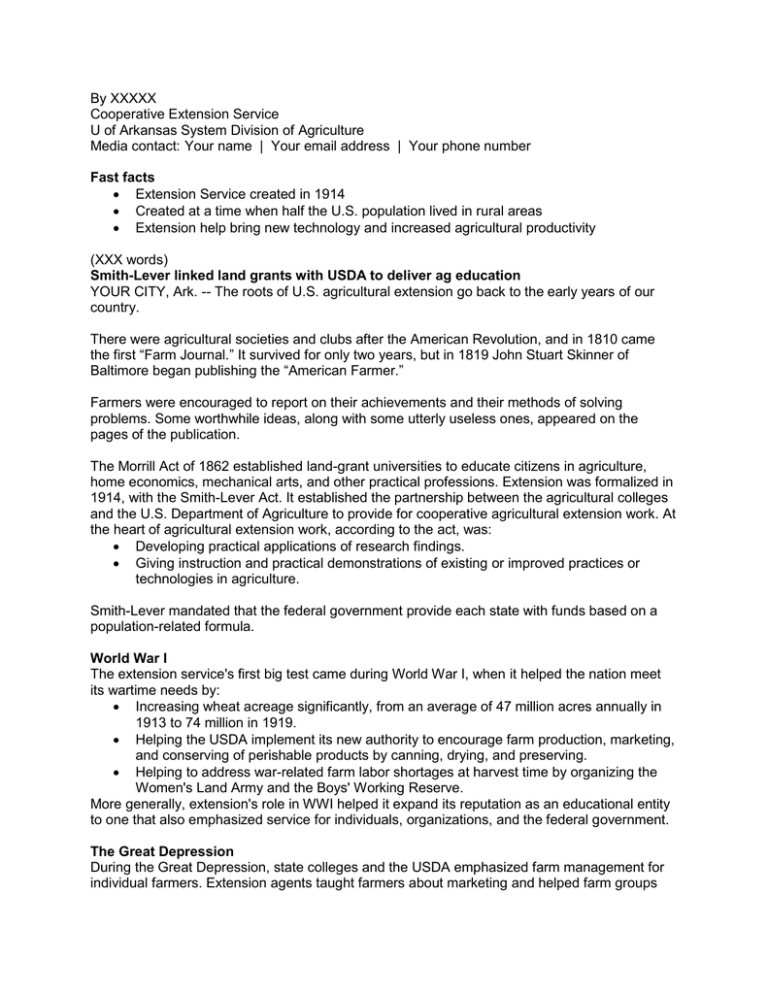By XXXXX Cooperative Extension Service U of Arkansas System Division of Agriculture
advertisement

By XXXXX Cooperative Extension Service U of Arkansas System Division of Agriculture Media contact: Your name | Your email address | Your phone number Fast facts Extension Service created in 1914 Created at a time when half the U.S. population lived in rural areas Extension help bring new technology and increased agricultural productivity (XXX words) Smith-Lever linked land grants with USDA to deliver ag education YOUR CITY, Ark. -- The roots of U.S. agricultural extension go back to the early years of our country. There were agricultural societies and clubs after the American Revolution, and in 1810 came the first “Farm Journal.” It survived for only two years, but in 1819 John Stuart Skinner of Baltimore began publishing the “American Farmer.” Farmers were encouraged to report on their achievements and their methods of solving problems. Some worthwhile ideas, along with some utterly useless ones, appeared on the pages of the publication. The Morrill Act of 1862 established land-grant universities to educate citizens in agriculture, home economics, mechanical arts, and other practical professions. Extension was formalized in 1914, with the Smith-Lever Act. It established the partnership between the agricultural colleges and the U.S. Department of Agriculture to provide for cooperative agricultural extension work. At the heart of agricultural extension work, according to the act, was: Developing practical applications of research findings. Giving instruction and practical demonstrations of existing or improved practices or technologies in agriculture. Smith-Lever mandated that the federal government provide each state with funds based on a population-related formula. World War I The extension service's first big test came during World War I, when it helped the nation meet its wartime needs by: Increasing wheat acreage significantly, from an average of 47 million acres annually in 1913 to 74 million in 1919. Helping the USDA implement its new authority to encourage farm production, marketing, and conserving of perishable products by canning, drying, and preserving. Helping to address war-related farm labor shortages at harvest time by organizing the Women's Land Army and the Boys' Working Reserve. More generally, extension's role in WWI helped it expand its reputation as an educational entity to one that also emphasized service for individuals, organizations, and the federal government. The Great Depression During the Great Depression, state colleges and the USDA emphasized farm management for individual farmers. Extension agents taught farmers about marketing and helped farm groups organize both buying and selling cooperatives. At the same time, extension home economists taught farm women—who traditionally maintained the household—good nutrition, canning surplus foods, house gardening, home poultry production, home nursing, furniture refinishing, and sewing—skills that helped many farm families survive the years of economic depression and drought. World War II During World War II, the extension service again worked with farmers and their families, along with 4-H club members, to secure the production increases essential to the war effort. Each year for 5 years, total food production increased. In 1944, food production was 38 percent above the 1935-1939 average. The Victory Garden Program was one of the most popular programs in the war period, and extension agents developed programs to provide seed, fertilizer, and simple gardening tools for Victory Gardeners. An estimated 15 million families planted Victory Gardens in 1942, and in 1943 some 20 million victory gardens produced more than 40 percent of the vegetables grown for that year's fresh consumption. Between 1950 and 1997, the number of farms in the U.S. declined dramatically—from 5.4 million to 1.9 million. Because the amount of farmland did not decrease as much as the number of farms, the remaining farms have a larger average acreage. During the same period, farm production increased from one farmer supporting the food needs of 15.5 persons in 1950 to one farmer supporting 100 persons in 1990. By 1997, one farmer supported the food needs of almost 140 U.S. citizens. That increased productivity, despite the decline in farm numbers, resulted from increased mechanization, commercial fertilizers, new hybrid seeds, and other technologies. Extension played an important role in extending these new technologies to U.S. farmers and ranchers. To learn more about the extension service in Arkansas, contact your county extension office, or visit www.uaex.edu. The Cooperative Extension Service is part of the University of Arkansas System Division of Agriculture and offers its programs to all eligible persons regardless of race, color, national origin, religion, gender, age, disability, marital or veteran status, or any other legally protected status, and is an Affirmative Action/Equal Opportunity Employer. ###
